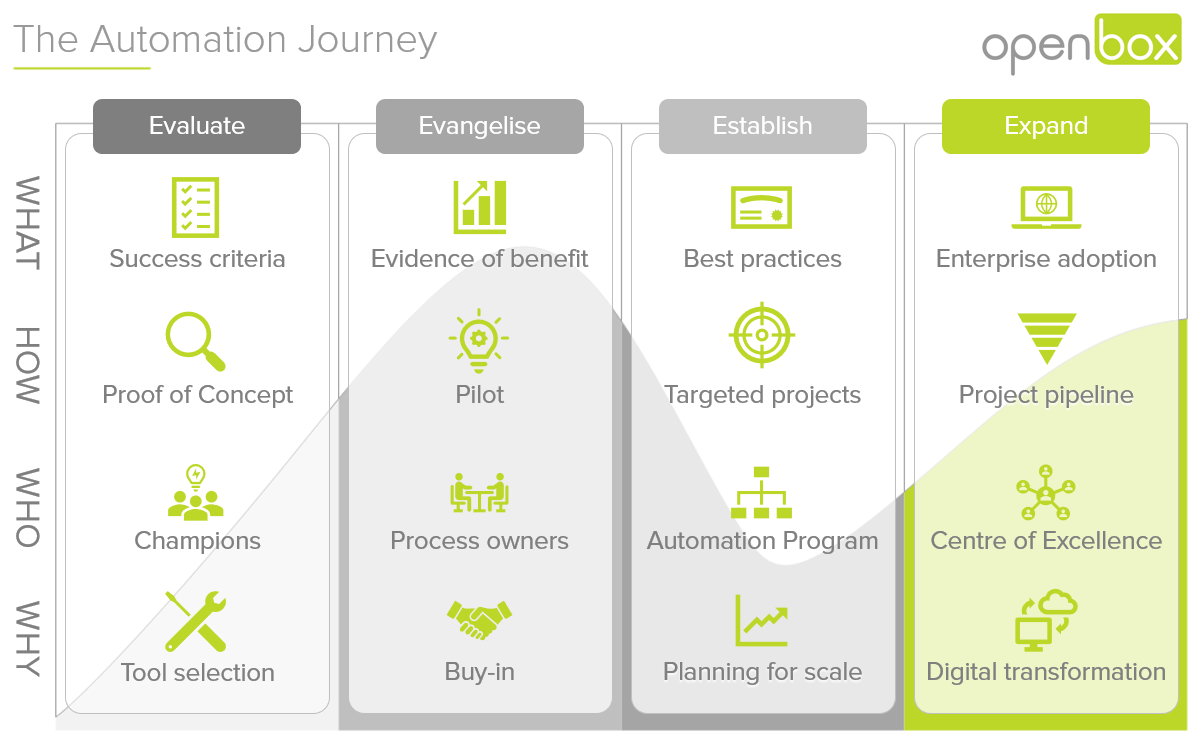Do the difficult things while they are easy and do the great things while they are small. A journey of a thousand miles must begin with a single step. - Lao Tzu, Chinese philosopher
Automation has been proven to work and is here to stay. Whether we’re talking about Robotic Process Automation or Artificial Intelligence, attended or unattended automation, or any of the combinations thereof, Real Estate companies have welcomed the transformative potential of this new technology. However, the industry is challenged by questions of where to start, what processes to automate, how to prove value, and how to scale from successful pilot to enterprise adoption.
At Open Box Software, we recognize that automation is not a project, but a journey. Let’s look at the steps your company will take on the road to automation success, and the questions to ask along the way.

Step 1: Evaluate
Choosing the right automation platform or partner is going to be key to your success; but knowing what your challenges and objectives are from the start will help you to make the right choice.
Many companies will set out to do the market research on automation and be quickly lost in the fog of available options. The questions roll in thick and fast:
- What’s the difference between attended and unattended automation?
- Are Robotic Process Automation (RPA), Intelligent Process Automation (IPA) and Artificial Intelligence (AI) all the same thing?
- What are controllers and why do I need them?
- Do I need to be concerned about data privacy with cloud hosted tools?
- What are my operating costs going to be?
In our experience, the challenge of tool selection can be simplified by preparing well. First and foremost, make sure you’ve addressed the most important question of all: what does success look like for us?
We recognize that automation is not a project, but a journey
To answer this, you will need the right people in the driving seat from the start. Champions or evangelists should come from both business and IT, and have the insight and authority to ensure the journey is in line with the organization’s strategic direction. Consulting with or hiring people who have experience in the field is also advisable. Why spend months re-treading ground that someone else has already walked?
Many companies will engage in a Proof of Concept test during this phase, to decide between shortlisted tools or to validate tool selection. Before you do so, be assured that the question of whether automation works has already been answered by dozens of case studies. Design your tests to find out if the tool will work in your environment, for your processes, and will meet your objectives.
Step 2: Evangelize
Education and promotion only go so far in bringing the organisation as a whole on board with your automation strategy. Evidence of benefit will speak louder than words.
Running a pilot to production with a single process is often a critical first step in convincing process owners, budget owners and other key stakeholders to invest their time and money in a long-term program of change. Selecting the right process to pilot is critical:
- The process should be well documented, mature and stable.
- There should be few exceptions to the process, and few dependencies.
- The input to the process should be well-structured, machine readable, and require minimal validation.
- The process owners and subject matter experts should be fully committed.
- The expected benefits should be clearly measurable.
When it comes to proof of benefit in a pilot project, cost saving is often seen as the easiest to prove and motivate at this stage. However, automating a single process is very unlikely to dramatically impact headcount in most Real Estate teams. Benefit at this scale is more likely to be found in freeing up time for people to engage in more value-add work, whether it be through direct time saving or reduction of errors and risk. Being clear about how you plan to calculate, measure and present the benefit is therefore key in pilot process selection.
Be careful not to become too focused on the delivery objectives of the pilot and lose sight of other factors that can impact your pilot’s success. Change management, training, communication and expectation management are vital to ensuring the new process fits in seamlessly with minimal disruption to the team. Losing the faith of the process owners through a perception that the automation has cost more of their time than it has saved is the surest way to end your automation journey when it has barely begun.
Step 3: Establish
So, your pilot was successful, and everyone is clamouring for you to automate their process next; how do you make the transition from innovation project to business as usual?
The trickiest stage of your journey will be preparing to scale your automation program. During this phase you will have many challenges to overcome:
- Growing from a few automation champions into an established, expert automation program team with governance and oversight.
- Creating an opportunity pipeline to allow you to gather, qualify and develop automation opportunities while keeping stakeholders informed and engaged.
- Establishing best practices for everything from project documentation to deployment management.
- Creating an operational support team to monitor and maintain the automations that have been delivered into production.
- Scaling your automation environment to meet the increased demand.
These challenges are by no means unique to automation, but as always, the devil is in the details. Because automation is often seen as a process rather than an application, it can easily fall through the cracks of an otherwise robust support ecosystem. For example, if you have automated data input into a key system, is the system’s upgrade schedule taking the automation into account? Is the automation team tied into your change advisory board? Does your helpdesk know how to distinguish between an automation issue and an application issue?
Automation does not exist in a vacuum
As you grow your program, the nature of the projects you select for automation will also change. The pilot is unlikely to have covered every aspect of what you want to test or prove, so the next tranche of projects must be carefully selected to fill in the gaps. Objectives should include automating against different key applications in your environment, demonstrating different types of process (e.g. data collation vs. data input) and demonstrating benefits that are not as easily measured (e.g. compliance, quality and risk reduction).
This is the time when expertise and experience are invaluable. Knowing where the potholes are, and how to avoid them, and knowing what other companies have done to successfully navigate this stretch of road can be the difference between reaching your destination or wandering aimlessly in the wilderness of failure to scale.
Step 4: Expand
The destination of your journey is automation as an established enterprise tool, and an enabler of digital transformation.
Automation is not simply a case of doing what you to today, only faster. It is an opportunity to tackle important organisational objectives that other technologies may have failed to address. Expanding your scope from straightforward process automation to automated solutions is the key to achieving the greatest value from the technology. When you begin to see automation as an enabler, great things become possible:
- Using the process focus of automation projects to encourage a transformational culture that balances people, process and technology.
- Supporting your integration strategies by providing more options for interfacing with legacy or external systems.
- Supporting your data strategies by helping to cleanse, transform and validate data efficiently and consistently.
- Augmenting knowledge workers with Artificial Intelligence tools that fit seamlessly into their workflows.
- Creating scalable processes that can flex up and down to respond to the varying volume of demands throughout the year, to market fluctuations, and to rapid growth.
Automation does not exist in a vacuum. Your approach to implementation should be a holistic one that aligns with your broader business and technology roadmaps. It should also be able to move quickly to capitalize on and respond to changes in the technologies, the market and the organisation. To this end, establishment of an automation Center of Excellence that brings together a multi-disciplinary team of stakeholders, automation experts and business users will ensure the company is getting the most out of its investment.
Take the First Step
If you are looking to augment and free your resources, redefine your standards in quality and efficiency, and transform the way your business operates, automation has the potential to deliver. Embark on your automation journey with a map, a compass, and some experienced travelling companions, and you’re sure to reach your destination!
To find out more about how Open Box Software can help you on your journey, take a look at our Automation Consulting and Robotic Process Automation services, or email us to get started.





